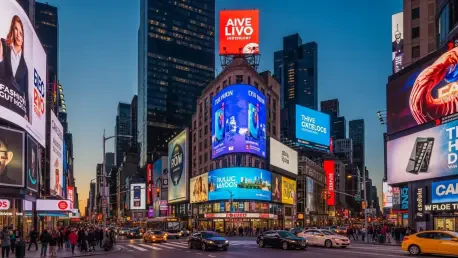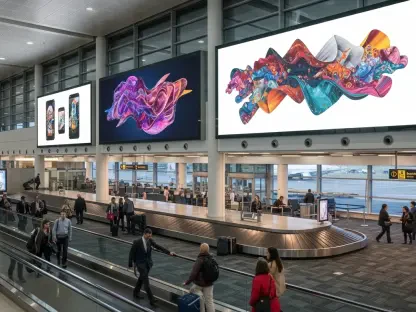Setting the Stage for Digital Transformation in Urban Advertising
Imagine walking through a bustling city center where every digital screen not only advertises the latest product but also alerts pedestrians to a sudden weather change or guides them during an emergency. This is the reality of Digital-Out-of-Home (DOOH) advertising in 2025, a market that has transcended traditional billboards to become a vital component of urban life. With the global DOOH market valued at $20.74 billion this year, its integration of real-time data and experiential technology is reshaping how cities communicate, engage, and ensure safety. This analysis delves into the current trends, growth projections, and strategic opportunities within the DOOH sector, highlighting its dual role in commerce and civic utility. The purpose is to provide stakeholders with actionable insights into a market poised for significant expansion, offering a lens into how technology is transforming urban landscapes.
Dissecting Market Trends and Growth Drivers
Real-Time Data as a Competitive Edge
A cornerstone of the DOOH market’s appeal lies in its ability to harness real-time data, making advertisements and public messages contextually relevant. By integrating inputs from weather sensors, traffic systems, and geofencing tools, digital screens can adapt content instantly to suit immediate conditions. For instance, beverage campaigns in major transit hubs adjust messaging based on train schedules, while emergency alerts override ads during crises like floods or power outages. This adaptability has fueled market growth, with projections estimating an increase from $20.74 billion in 2025 to $39.12 billion by 2030, reflecting a compound annual growth rate (CAGR) of 10.7%. The challenge lies in balancing data usage with privacy concerns, yet the advantage of delivering timely information positions DOOH as an indispensable urban tool.
Experiential Campaigns Driving Engagement
Beyond data, the DOOH sector is capitalizing on immersive technologies to transform urban spaces into interactive hubs. Augmented reality (AR) and digital kiosks enable campaigns that invite active participation, such as virtual product trials displayed on city screens that captivate passersby. These initiatives not only boost brand visibility but also enhance social media reach, as users share their unique experiences online. While high costs and accessibility issues pose barriers, the potential to deepen consumer connections through innovative storytelling is a significant driver of market interest. This trend underscores DOOH’s evolution from static displays to dynamic platforms that resonate with urban dwellers on a personal level.
Regional Leadership and Market Disparities
Geographic variations add another layer to the DOOH market’s dynamics, with North America commanding a 36% share in 2025 due to early adoption of smart digital infrastructure. The region’s advanced technological ecosystem supports seamless integration of DOOH into urban settings, particularly in high-traffic areas like shopping districts. Conversely, the Asia-Pacific region is emerging as a growth hotspot, driven by expansive smart city projects that incorporate digital displays into public transit and commercial zones. However, disparities in infrastructure and regulatory frameworks across regions create uneven adoption rates, necessitating tailored strategies to maximize market penetration. Understanding these regional nuances is critical for stakeholders aiming to capitalize on global opportunities.
Forecasting Future Opportunities and Challenges
Technological Innovations on the Horizon
Looking toward the next five years, the DOOH market is set to benefit from advancements in artificial intelligence (AI) and programmatic advertising, which will refine content personalization and delivery. Partnerships with smart city initiatives are expected to embed DOOH deeper into urban frameworks, enhancing data integration for both commercial and civic purposes. Emerging technologies like virtual reality (VR) could further elevate experiential campaigns, making city streets hubs of immersive interaction by 2030. These innovations promise to amplify the market’s value, yet they also introduce complexities around data security and the energy demands of digital screens, pushing the industry toward sustainable solutions.
Regulatory and Ethical Considerations
As the DOOH market expands, regulatory landscapes will play a pivotal role in shaping its trajectory. Stricter data privacy laws could impose constraints on how real-time information is collected and used, requiring robust compliance mechanisms. Additionally, environmental concerns over the power consumption of digital displays are prompting calls for greener technologies, which may increase operational costs in the short term. Navigating these challenges will be essential for maintaining consumer trust and ensuring long-term growth, as stakeholders must balance innovation with accountability. Proactive adaptation to these evolving standards can position companies as leaders in a responsible market space.
Reflecting on Strategic Pathways Forward
Looking back, this analysis uncovers how the DOOH market has woven itself into the fabric of urban life in 2025, driven by real-time data and experiential engagement to achieve a valuation of $20.74 billion. The projected growth to $39.12 billion by 2030 underscores the sector’s immense potential, while regional disparities and technological advancements paint a complex yet promising picture. For stakeholders, the next steps involve investing in AI and AR technologies to stay ahead of personalization trends, while property developers could prioritize multifunctional screens in high-traffic zones for dual revenue streams. City planners might focus on integrating DOOH into emergency systems to bolster public safety. Ultimately, forging partnerships with tech providers and smart city initiatives offers a pathway to harness this market’s transformative power, ensuring that digital screens continue to serve as both economic engines and civic lifelines.









